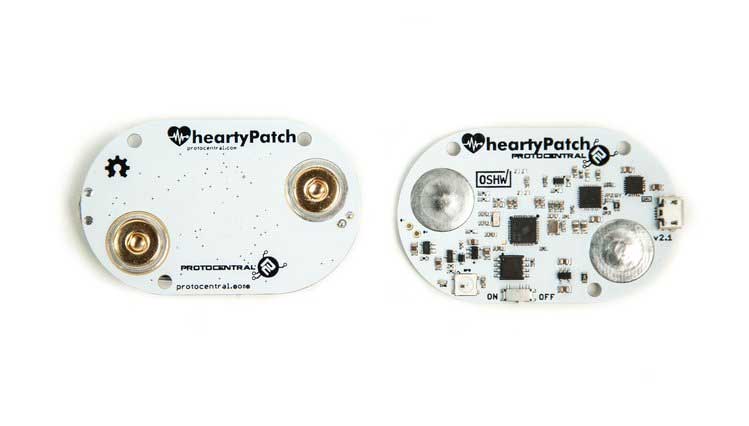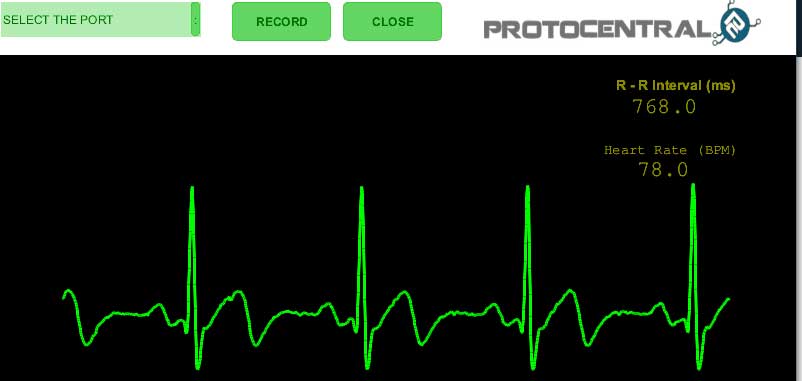An ECG patch that’s open source, affordable, and Wi-Fi/Bluetooth connected.
HeartyPatch is a completely open source, single-lead, ECG-HR wearable patch with HRV (Heart Rate Variability) analysis. It is based on the popular ESP32 system-on-a-chip. By using low-cost, highly-integrated components, we are able to keep the BOM’s cost low, while the simplicity of the circuit design means future expansion will be easier. HeartyPatch can be used both as a lifestyle device for managing fitness and stress as well as for diagnostics and medical research, with the potential for even more interesting applications.
Currently available low-cost, wearable heart monitors are usually based on less accurate optical measurements while the actual electrocardiography-based monitors are either too expensive or difficult to use. Similarly, heart-rate variability (HRV) data is used in fitness and training, but can also be used to detect some of the basic cardiac arrhythmias. Getting accurate R-R intervals for HRV studies is also tricky with most heart-rate monitors.
 What is Heart-rate Variability?
What is Heart-rate Variability?
Heart-rate variability, or HRV, is a measure of the variance of heart-rate in real-time. More specifically, it is the time difference between two R-R intervals (the signal peaks) in an electro-cardiogram (ECG or EKG) plot.
Studies of heart-rate variability have shown that HRV can be indicative of some common forms of arrhythmia, including atrial fibrillation (AF) and atrial tachycardia (AT), among others. HRV can be detected with a single lead ECG, like HeartyPatch, which, for cardiac patients being monitored for such forms of arrhythmia, is much easier to wear long term than a full Holter configuration (three or five leads).
In fitness applications, some high-performance athletes train using biofeedback for heart-rate control and also for knowing when to start and stop training (based on heart-rate).
HRV has also be known to reflect emotion, mood, anxiety, and stress. When such psychological events happen, there is a known pattern of variance in heart rate. This makes HRV useful tool for studying mood and managing stress in people who are prone to such psychological states.
Finally, since HeartyPatch can detect individual heart-beats in real-time, it can also be used in the areas of design and non-medical wearables to detect heart beats to activate lights or any other form of feedback. Cardio-biofeedback is an example of controlling heart-rate.
Who Needs HeartyPatch
- Medical professionals, caregivers, and researchers (for continuous event monitoring)
- High performance sports and fitness professionals (for precision cardio training)*
- Hardware/software developers (as a reference design)
- Curious poeple (because knowing your own heart-patterns is cool)
*Activities that cause sweating can prevent adhesive electrodes from adhering properly.
HeartyPatch Modes of Operation
HeartyPatch is open source. This means that the software on the device can be modified to work in any way you choose, providing access to raw heart-rate and inter-beat interval (IBI) data. Because of this flexibility, HeartyPatch can be operated in any or all of the following modes. * Continuous ECG streaming mode displays live ECG recording from the chest. This works similar to a heart-rate monitor. Below is a screen capture of the device working in ECG mode.
- Beat-to-beat mode can be displayed by flashing the on-board LED or you can stream live, instantaneous heart rate over BLE for immediate detection of changes in inter-beat intervals.
- Arrhythmia detection mode runs the arrhythmia algorithm in real-time and detects events of AFIB.
- Heart-rate variability mode is available when HeartyPatch is connected to the desktop app, which displays the cardio-tachogram (CTG), Poincaré plot (variance), and histogram of inter-beat intervals. Below is a plot of data taken from an ECG simulator that is physically connected to the HeartyPatch.
Technical Specifications:
- Main Microcontroller: ESP32 SoC with two-core CPU and Wi-Fi/Bluetooth
- Maxim MAX30003: analog front-end for ECG
- Onboard Snap-on Buttons: connectors for disposable electrode pads
- RGB LED: for status indication and UI
- USB-UART: bridge based on CP2104
- Micro USB: connector for programming, data, power, and battery charging
- PCB Dimensions: 65 mm x 42 mm x 4 mm (~2.56” x 1.65” x 0.16”) without battery
- Dimensions with Case: ~70 mm x 46 mm x 12.7 mm (~2.75” x 1.81” x 0.50”)
How HeartyPatch Compares
HeartyPatch has considerable advantages over other low-price heart monitors:
- ECG-based R-R Interval Measurement: electrical measurement of heart rhythm has been shown to be more accurate than optical heart-rate measurement
- Wide Dynamic Range: for robust functioning during movement (not available in traditional ECG monitors)
- Mathematical and Machine Learning Algorithms: for automatic detection of arrhythmia, stress, and several other physiological conditions (not available with regular heart-rate patches)
- Small, Wearable Form-factor: with snap connectors for disposable, pre-gelled ECG electrodes makes it easy and hygienic to use compared with fabric-based electrodes. It is also easier to get these electrodes from any medical supplies store and their use is not limited by brand or make.
- Open Source and Non-proprietary – can be used with any software or algorithm
What’s in the Kit?
Basic Kit
- HeartyPatch board
- 450 mAH Li-Ion battery (connected and adhered to the board)
- Set of 10 disposable electrode pads
3D Printed Case
This enclosure allows for comfortable longer-term use. It is a clear 3D printed “clam-shell” style enclosure with snap-fits to close the two parts together. This is not an injection molded commercial-grade enclosure, but is 3D printed with PLA. The enclosure can be bought from this page along with the HeartyPatch, or you can download the open source 3D model from our website and print it out on any available 3D printer.
Open Source – Open Hardware
Open source means that a product truly belongs to the owner. You can understand, change, and use your hardware and software however you see fit. This control is especially important when it comes to health. So HeartyPatch is an open source project with files available on our GitHub repository: https://github.com/Protocentral/protocentral_heartypatch.
Manufacturing Plan
Manufacturing, assembly, and testing will be done at our own facility in Bangalore, India. We have our own assembly and testing facility for low volume production. This includes a small pick-and-place machine, ovens, and microscope inspection equipment. We also have our own team with testing and inspection expertise at our office/assembly facility in Bangalore, India.
All the components for HeartyPatch are from authorized, well-known vendors, primarily Digi-Key. This includes even smaller components such as capacitors and resistors to ensure we get consistent signal quality and reproducibility of signals each time, every time.
We have already successfully run, completed, and delivered the HealthyPi-v3 campaign right here on Crowd Supply. All deliveries have been on time as promised and we know the challenges associated with crowdfunding which puts us in a better position to deliver on time.
We have already fully executed two revisions of the HeartyPatch design, and the device is currently stable.
Shipping & Fulfillment
Due to the high cost of shipping and given the high volume of orders expected, Crowd Supply will be handling fulfillment. All orders wwill ship from Crowd Supply headquarters located in Portland, OR in the United States. Please see https://www.crowdsupply.com/guide/supporting-projects#ordering-paying-shipping-the-details for shipping details.
Customs import duty and taxes may apply for certain countries and certain customers. All the clearance procedures will be performed by the courier, but the customer is responsible for paying any import duties/taxes, if applicable.
Risks & Challenges
As HeartyPatch functionality is currently stable and tested, we don’t foresee any issues that aren’t inherent in manufacturing a product generally. There is always a chance of component shortage or equipment down time that restult in delivery delays. Shipping can also hold back any project if packages are lost or damaged in transport. We’ll keep the delivery timelines as up-to-date as possible and provide regular status updates during production.
A Note About BLE on the ESP32 Module
The ESP32 device on HeartyPatch does not currently support Bluetooth operation in Low Energy Mode (as of September 28, 2017). It supports all the BLE profiles as expected, but the baseband works only in Bluetooth Classic mode. This means that the power consumption by the Bluetooth radio when connected WILL NOT meet the expectations of BLE. This is supposed to fixed in the next release, but could take longer, according to the Espressif team. This will ONLY affect the battery life of the device and does not affect functionality in any way.
Important Notice: Although it has all the features of a clinical grade heart monitor and could function as one, HeartyPatch does not have any certifications (FDA/CE/IEC) and is not approved for medical or diagnostic use. It is your responsibility to ensure your safety when using the device. Never power the device from a non-isolated power source.








